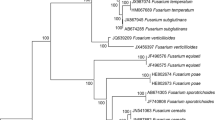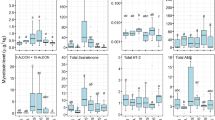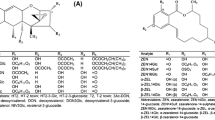Abstract
The fungus Fusarium verticillioides is a pathogen of many plants and produces fumonisins. In addition to their well-studied animal toxicoses, these toxins contribute to the development of maize seedling disease in susceptible maize varieties. Fumonisin disruption of sphingolipid biosynthesis occurs during pathogenesis. An extraction method was developed for the simultaneous analysis of fumonisins B1 (FB1), B2 (FB2) and B3 (FB3), free sphingoid bases and sphingoid base 1-phosphates in maize tissues by liquid chromatography/linear ion trap tandem mass spectrometry. The method involved a single extraction using 1:1 acetonitrile:water + 5% formic acid (1 ml per 10 mg tissue). Mean recoveries ranged from approximately 50 to 99 percent, and limits of detection ranged from 10 fg μl−1 to 6900 fg μl−1. To test the efficacy of the method, seeds of a susceptible maize line were inoculated with a pathogenic, fumonisin-producing strain of F. verticillioides. The seedlings were then harvested, and fumonisin content, as well as sphingoid bases and their 1-phosphates, were measured in the leaf and root tissues. Fumonisin accumulation was significantly greater in leaf one compared to leaves two and three. While FB1, FB2, and FB3 were detected in root tissues, FB1 was preferentially accumulated in leaf tissues. Accumulation of sphingoid bases and their 1-phosphates was evident in roots and leaves of seedlings grown from inoculated seed, with the level of accumulation being similar in leaves 1, 2 and 3. The method developed was effective, fast, and sensitive for use in simultaneously measuring fumonisin in tissues and their effects on sphingolipid metabolite biomarkers of disease. The method should be useful for screening maize cultivars for susceptibility to F. verticillioides-induced seedling diseases.

Lesion with chromatography





Similar content being viewed by others
References
Cook RJ (1981) Water relations in the biology of Fusarium. In: Nelson PE, Toussoun TA, Cook RJ (eds) Fusarium: diseases, biology, and taxonomy. The Pennsylvania State University Press, University Park, PA
Kommedahl T, Windels CE (1981) Root-, stalk-, and ear-infecting Fusarium species on corn in the USA. In: Nelson PE, Toussoun TA, Cook RJ (eds) Fusarium: diseases, biology, and taxonomy. The Pennsylvania State University Press, University Park, PA
Wang E, Norred WP, Bacon CW, Riley RT, Merrill AH (1991) J Biol Chem 266:14486–14490
Marasas WFO, Kellerman TS, Gelderbloom WCA, Coetzer JAW, Theil PG, Van der Lugt JJ (1988) Onderstepoort J Vet Res 55:197–203
Ross PF, Nelson PE, Richard JL, Osweiler GD, Rice LG, Plattner RD, Wilson TM (1990) Appl Environ Microbiol 56:3225–3226
IARC (2002) Some traditional medicines, some mycotoxins, naphthalene and styrene (IARC Monographs on the Evaluation of Carcinogenic Risks to Humans, vol 82). IARC Press, Lyon, France
Marasas WFO, Riley RT, Hendricks KA, Stevens VL, Sadler TW, Gelineau-van Waes J, Missmer SA, Cabrera J, Torres O, Gelderblom WCA, Allegood J, Martínez C, Maddox J, Miller JD, Starr L, Sullards MC, Roman AV, Voss KA, Wang E, Merrill AH Jr (2004) J Nutr 134:711–716
Williams LD, Glenn AE, Zimeri AM, Bacon CW, Smith MA, Riley RT (2007) J Agric Food Chem 55:2937–2946
Desjardins AE, Plattner RD, Nelsen TC, Leslie JF (1995) Appl Environ Microbiol 61:79–86
Rheeder JP, Marasas WFO, Vismer HF (2002) Appl Environ Microbiol 68:2101–2105
Bartok T, Szecsi A, Szekeres A, Mesterhazy A, Bartok M (2006) Rapid Commum Mass Spectrom 20:2447–2462
Riley RT, Enongene E, Voss KA, Norred WP, Meredith FI, Sharma RP, Williams D, Carlson DB, Spitsbergen J, Merrill AH Jr (2001) Environ Health Perspect 109:301–308
Abbas HK, Tanaka T, Duke SO, Porter JK, Wray EM, Hodges L, Sessions AE, Wang E, Merrill AH Jr, Riley RT (1994) Plant Physiol 106:1085–1093
Merrill AH Jr, Sullards MC, Wang E, Voss KA, Riley RT (2001) Environ Health Perspect 109:283–289
Ng CK-Y, Hetherington AM (2001) Ann Bot 88:957–965
Worrall D, Ng CK-Y, Hetherington AM (2003) Trends Plant Sci 8:317–320
Lynch DV, Dunn TM (2004) New Phytol 61:677–702
Coursol S, Stunff HE, Lynch DV, Gilroy S, Assman SM, Spiegel S (2005) Plant Physiol 137:724–737
Shi L, Bielawski J, Mu J, Dong H, Teng C, Zhang J, Yang X, Tomishige N, Hanada K, Hannun YA, Zuo J (2007) Cell Res 17:1030–1140
Glenn AE, Zitomer NC, Zimeri AM, Williams LD, Riley RT, Proctor RH (2008) MPMI 21:87–97
Harris DC (2003) Quantitative chemical analysis. WH Freeman and Company, New York
Bacon CW, Hinton DM, Richardson MD (1994) Plant Dis 78:302–305
Merrill AH, Wang E, Mullins RE, Jamison WCL, Nimkar S, Liotta DC (1988) Anal Biochem 171:373–381
Min JK, Yoo HS, Lee EY, Lee WJ, Lee YM (2002) Anal Biochem 303:167–175
Sullards MC, Merrill AH (2001) Sci STKE 2001:pl1
Markam JE, Jaworski JJ (2007) Rapid Commum Mass Spectrom 21:1304–1314
Acknowledgements
The authors wish to thank Ms. Jency Showker and Ms. Britton Ormiston for their outstanding technical assistance.
Author information
Authors and Affiliations
Corresponding author
Rights and permissions
About this article
Cite this article
Zitomer, N.C., Glenn, A.E., Bacon, C.W. et al. A single extraction method for the analysis by liquid chromatography/tandem mass spectrometry of fumonisins and biomarkers of disrupted sphingolipid metabolism in tissues of maize seedlings. Anal Bioanal Chem 391, 2257–2263 (2008). https://doi.org/10.1007/s00216-008-2166-x
Received:
Revised:
Accepted:
Published:
Issue Date:
DOI: https://doi.org/10.1007/s00216-008-2166-x




